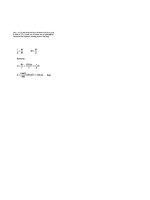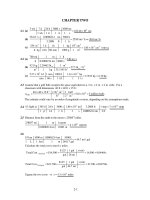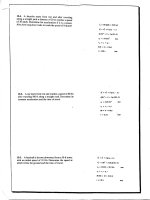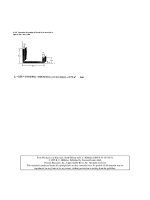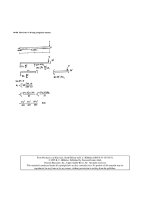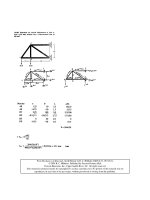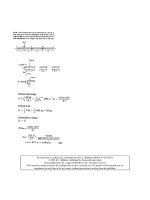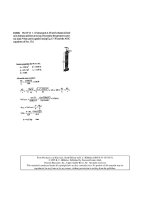estática décima edición - hibbeler (solucionario)
Bạn đang xem bản rút gọn của tài liệu. Xem và tải ngay bản đầy đủ của tài liệu tại đây (19.81 MB, 718 trang )
Instructor's Solutions
Manual
ENGINEERING
MECHANICS
STATICS
TENTH
EDITION
R.
C.
Hibbeler
Pearson Education, Inc.
Upper Saddle River, New Jersey 07458
Executive Editor: Eric Svendsen
Associte Editor: Dee Bernhard
Executive Managing Editor: Vince O'Brien
Managing Editor: David
A.
George
Production Editor: Barbara
A. Till
Director of Creative Services: Paul Belfanti
Manufacturing Manager: Trudy Pisciotti
Manufacturing Buyer: Ilene Kahn
About the cover: The forces within the members of this truss bridge must be
determined if they are to be properly designed. Cover Image: R.C. Hibbeler.
© 2004 by Pearson Education, Inc.
Pearson Prentice Hall
Pearson Education,
Inc.
Upper Saddle River,
NJ
07458
All rights reserved. No part
of
this book may be reproduced in any form or by any
means, without permission in writing from the publisher.
The author and publisher
of
this book have used their best efforts in preparing this
book. These efforts include the development, research, and testing
of
the theories and
programs to determine their effectiveness. The author and publisher make no warran-
ty
of
any kind, expressed or implied, with regard to these programs or the documen-
tation contained in this book. The author and publisher shall not be liable in any
event for incidental or consequential damages in connection with, or arising out of,
the furnishing, performance, or use
of
these programs.
Pearson Prentice Hall®
is
a trademark
of
Pearson Education, Inc.
Printed in the United States
of
America
10
9 8 7 6 5 4 3 2 1
ISBN
0-13-141212-4
Pearson Education Ltd., London
Pearson Education Australia Pty. Ltd., Sydney
Pearson Education Singapore, Pte. Ltd.
Pearson Education North Asia Ltd.,
Hong Kong
Pearson Education Canada, Inc., Toronto
Pearson Educaci6n de Mexico, S.A. de
c.v.
Pearson
Education-Japan,
Tokyo
Pearson Education Malaysia, Pte. Ltd.
Pearson Education, Inc.,
Upper Saddle River, New Jersey
Contents
1
General Principles
1
2
Force Vectors
5
3
Equilibrium of a Particle
77
4
Force System Resultants
129
5 Equilibrium of a Rigid Body
206
6 Structural Analysis
261
7 Internal Forces
391
8 Friction
476
9
Center of Gravity
and
Centroid
556
10
Moments of Inertia
619
11
Virtual Work
680
iii
figure~:
(a)
4.65735
m,
(b)
55.578
S,
(c)
4555
N,
(d)
2768
kg.
a)
4.66 m b)
'5.6
s c) 4.56
kN
d) 2.77
Ma
I
~ II
1.2. Wood
has
a density
of
470
sIugjft3 . .
density expressed in
SI
units?'
.
What
IS
Its
{
(1it')(14.5938
kg)
}
242
Mslm'
(4.70a1ug/tt') (0.3048 m)3(1 slug) = .
Aas
1 _.
__
_
_ _
1·3. Represent each
of
the following quantities in the
correct
SI
form using an appropriate prefix: (a)
0.000431
kg.
(b)
35.3(10~)
N,
(c) 0.00532 km.
a)
0.00043lkg=0.000431(IO
l
) 11=0.
431
1
Ans
b)
3S.3(
10l)
N = 35.3 kN
c)
0.00532 Ian = 0.OOS32( lal) m = 5.32 m
"'Id
~
:
""
-
~
.1
Rep~~sent
each
of
the following
combinations
of
uniiS in
the
correct
SI form using
an
appropriate
prefix:
(aJ
mlms, (b)
JLkm,
(c)
kslmg.
and
(d)
km·
JLN.
(
m )
(10>'
m)
(
a)
mlms =
~
- laD/s
(10)-' S S
(
(10)'
S)
((10)9
S)
Os/kg
(c)
ts/1111
=
~
kg
-
Ans
Ans
Ans
Ans
t
1.5. If a car
is
traveling at
55
mi/h, determine its speed
in.kilometers per hour and meters
per
second.
SS
mi/h
(~)(S280ft)(~)(~)
I h I IDI I ft 1000 m
'"
88.S
km/h
Ans
88.5 km/h =
__
-
246
mls
(
88.Skm)(IOOOm)(
Ih
)
Ih
Ikm
3600s
- .
1 _._ _._ _._
1-6.
EvaIuateeach
of
the
follOwing
and
express with
an
appropriate
prefix:
(a)
(430 kg)2
(b)
(0.002 mg)2
and
(c) (230m)3, ' •
(a)
(b)
(c)
(430
kg)'
= 0.185(10')
kg'
=
O.ISS
Mi
(O'(lO2
q)'
=
[2(10"')
sf
=
4p.,·
(230
m)'
= [0.23(10')
m]'
= 0.0122 laD'
ADI
-~ ~'~ ~ 4
1·7. A rocket has a mass
of
250(10~)
slugs on earth.
Specify (a) its mass
in
SI units, and (b) its weight in SI
units. If the rocket
is
on the moon, where the acceleration
due to gravity
is
gm
= 5.30 ft/s2. determine to three
significant figures (c) its weight
in
SI units, and (d) its
mass
in
SI
units.
u .ine
Table
1 • 2
IIId
i&lPlyinl
Eq.1
-
3,
we
have
a)
lSO(
lal)
.lup
=[2S0(
10l)
.IU
IS
](14.S938
kJ)
I
slulIS
=
3.6484'(
10')
kJ
=3.6'01
b)
W.
=
ml
=[3.6484'(
10')
kl
](
9.81 m/s2)
= 35.791
(10·)
k8' m/s2
= 35.8
MN
Or
Ans
Ans
1
c)
W.
= mI. =
[lSO(
10
3
)
SIUIS]
(
S.30
ftls2)
(
4.4482N)
= [
1.32'
(10')
lb]
lii)
'"'
,.894(
10')
N =
'.89
MN
(
'. )
(5.30
ftlS2)
.0
MN
W.
=
W.
- =
(3'.791
MN)
,
= S
9
• I
32.2ftls·
d)
Since
the
mass is
independent
of
its locaIion. then
m = m. =
3.6S(
10')
k8 = 3.65
01
Aid
Ans
*1-8.
Represent
each
of
the
following
combinations
of
units in
the
correct
SI
form:
(a)
kN/fLS,
(b)
MglmN,
and
(c)
MN/(kg'
ms).
(a)
(b)
(e)
I<N/}Js =
IO'N/(10-6)s
=
ON/s
ADS
Mg/mN
=
Htg/lO-'N
=
Og/N
ADS
MN/(kg·ms)
= lo"NIkg(10-'s) =
ON/(kg.s)
ADS
1
,
1-9. The pascal (Pa)
is
actually a very small unit of
pressure. To show this, convert
I
Pa
= I N/m2 to Ib/ft2.
Atmospheric pressure at sea level
is
14.7 Ib/in2.
How many pascals
is
this?
1-10. What
is
the weight in newtons
of
an object
that
has a mass of: (a) 10 kg, (b)
0.5
g,
(c) 4.50 Mg? Express
the result to three significant figures.
Use an
appropriate
prefix.
o
sing
Table
1-
2. we
have
=~(~)(0.30481
ml)
= 20.9 (
10-')
Ib/ftl Ans
1 Pa
ml 4.4482 N I ftl
=~(~)(~)(
lftz
)
I
ATM
inl
I
Ib
I ftl 0.30481
ml
=
101.3
(
10')
N/ml
= 101ltPa
AIlS
(al
(bl
(el W = (9.81 m/sl)(4,S
Mg)(lo'
kg/Mg) =
44.1
kN
ADS
1 _ _
_-_._._ ,
I-IL
Evaluate each
of
the
following
to
three significant
figures
and
express each answer
in
SI
units using an
appropriate
prefix: (a) 354 mg(45 km)/(0.035 6 kN),
(b)
(.004 53 Mg)(201 ms), (c) 435
MN/23.2
mm.
a)
(3S4mg)(4Skm)/o.o3S6kN
=
[3S4(10-')
g][4S(1O') m]
0.03S6( 10') N
= 0.447(10')
g.
m
N
= 0.447-kg .
mIN
Ans
b)(0.00453 Mg)(201
IDS)
=[4.53(
10-')(
10')
kg][201(
10-')
5]
= 0.911 kg. S
Ans
43S(1O") N 18.75(10') N
e)
43S
MN/23.2
mm
= - =
18.8
GN/m
Ans
23.2(10-')
m m
1 _
_ ,
*1-12.
Convert each of the following and express the
answer using an appropriate prefix: (a)
175Ib/fP
to
kN/m
3
,
(b)
6
ftlh
to
mm/s,
and
(c) 835
lb·
ft
to
kN.
m.
(
1751b)(
It
)'(4.4482
N)
(al
175
Ib/ft'
=
til
0.3048 m
lb-
= (27.5
~~l'
N)
= 27.5
kN/m'
(
6 ft)(0.3048
m)(
1 h )
(bl 6
ftlh
= h
-I-r-t
- 3600 s
=
0.508(10)"'
m/s
= 0.508 mm/s
(
4.4482
N)(0.3048
m)
(el
835
Ib·ft=
(8351b·ft)
1fu
-I-[-t-
= 1.13(10)'
N·
m = 1.13 kN· m
Ans
Ans
Ans
1·13. Convert each of the following to three significant
figures.
(a) 20
Ib
.
ft
to N .
m,
(b) 450 Ib/ft
J
to kN/m
J
,
and
(c)
15
ft/h
to mm/s.
U
sinS
Table
1 - 2. we have
a)
20 lb·
fl=
(20 lb·
fl)(~)(~)
lIb
I
fl
=27.1
N'm
Ans
b) 4501blfl] =
(450
Ib)(~)(~)(
lftl )
ft]
1
Ib
1000
N 0.3048] m]
=
70.71cN/m]
ADS
c)
15
ftlh =
(¥)(304~
~Imm
)(3~
s)
=
1.27
mm/s
ADS
1
____________
.
____________
.
__
. - _______ .
___
.
___
.
__
-11
1·14.
If
an object has a mass
of
40 slugs, determine its
mass
in
kilograms.
1·15.
Water
has
a density
of
1.94
slug/fe. What
is
the
density expressed
in
SI
units? Express the answer to three
significant
figures.
40
slugs (14.5938 kg/slug) = 584 kg
Using Table
1-2.
we
have
Pw
= (1.94
SIU
g
)(14.5938 k
g
)(
I ftl )
fl]
I slug
0.3048]
m]
= 999.8 kg/m] =
1.00
Mg/m]
ADS
ADS
1 _._ _
_
*1·16. Two particles have a mass
of
8 kg and 12
kg,
respectively.
If
they are 800 mm apart, determine
the
force
of
gravity acting between them. Compare this result with
the weight
of
each particle.
1·17. Determine the mass of
an
object that
has
a weight of (a) 20
mN,
(b) 150
kN,
(c)
60
MN.
Express
the answer to three significant
figures.
F=G~
7
2
Where G =
6.673(10-")
m'/(kg.s
2
)
W,
= 8(9.81) = 78.5 N
W
2
= 12(9.81) = 118 N
Applying
Eq.I-
3, we
have
m = ! = 20( 10-]) kg· m/sl =
2_04
g
a) g 9.81 m/s
2
ADS
b) W 150(103) kg·
m/sl
= 15.3
Mg
ADS
m=,
= 9.81 m/sl
c) m = ! = 60( 10") kg· m/sl = 6.12
Gg
ADS
g 9.81
m/sl
AIlS
AIlS
Ans
~~~====~
1·18.
If
a
man
weighs
155
lb
on
earth,
specify
(a)
h~s
mass
in
slugs, (b) his mass
in
kilograms,
and
(c)
hIS
weight
in
newtons.
If
the
man
is
on
the
moon,
where
the
acceleration due
to
gravity is
gm
=
5.30
ft/S2,
determine
(d)
his
weight
in
pounds,
and
(e)
his
mass
in
kilograms.
(a)
(b)
(c)
(d)
(e)
Also,
m =
155
=
4.81
slug
32.2
- [14.5938
kg]
_
702
m -
155
_
32.2
w =
155
(4.4482) =
689
N
[
5.30J
W =
155
- =
25.5
Ib
32.2
- [14.5938
kg]
_
70
2
"'n
m - ISS _
32.2
[
14.5938
kg]
02
"'n
m =
25.5
= 7
5.30
Ans
L ,
1-19. Using the base units of the SI system, show that
Eq.
1-2
is
a dimensionally homogeneous equation which
gives
F
in
newtons. Determine to three significant figures
the gravitational force acting between two spheres that
are touching each other. The
mass
of each sphere
is
200
kg
and the radius
is
300
mm.
*1-20. Evaluate each of the following to three significant
figures and express each answer
in
SI units
using
an appropriate prefix: (a)
(0.631
Mm)/(8.60 kgF,
(b)
(35
mm)2(48 kg)J.
Using
Eq.1-
2.
F=G~
rZ
N=(
~)(kg.kg)=
kg·m
ED
(Q . • . J
kg.
SZ
ml
Sl
F=G~
rZ
=
66.73
(
1O-1Z)[~J
O.@
= 7.41
(10-
6
) N =
7.41
~N
Ans
(a)
0.631
Mml(8.60kg)l
,"(0.631(10')
m)=
~
(8.60)2 kgl
kgZ
8.S3(lo-')m/kg
l
=
8.S31cm/1cg
Z
4
Ani
' ~====~==~
2-L Detennine the magnitude
of
the resultant force
F
R =
Fl
+
F3
and its direction, measured counterclockwise
from the positive
x
axis.
FR
=
1{6(0)2
+ (SOO)' _ 2{6(0){SOO)cos7S0 = 866.91 = S67 N
}j
=600N
6 = 63.05°
tP
= 63.05° + 45° =
10So
AIlS
~~~lll ~~
__
x
2·2. Determine the
~gnitude
of
the resultant force
if:
(a)
FR=
FI + F
2
;
(b)
FR
=
FI
- F
2
•
PlITalldolram
La ,
: The parallelogram
Jaw
ofaddilion is shown in
Fig. (a) and
(c).
TrilOlJomlt"
: Using law
of
cosines [Fig. (b) and
(d)].
we
have
a)
b)
FR
=
11()()2+S02-2(lOO)(80)cos
75'
= 111 N
FR'
= /1()()2 +
802
-2(
1(0)(80)
cos 1050
=
143N
ADS
ADS
2-3.
Determine the magnitude
of
the resultant force
F
R =
Fl
+
F2
and its direction, measured counterclockwise
from the positive x
axis.
y
FI
=2S01b
FR
=
/{2S0)2
+ (37S)2 - 2{2S0){375)coa7So = 393.2 =
3931b
393.2 250
I , x
*2-4.
Determine
the
magnitude
of
the
resultant
force
F R = Fl +
F2
and its direction, measured clockwise from
the positive
u
axis.
~
=
iin6
6 = 37.S9°
tP
= 360° - 45° + 37.89" = 3530
ADS
FR
=
/(300)'
+ (SOO)' - 2(300){SOO)cos95° = 605.1 =
60SN
ADS
, r u
605.1
SOO
sin9So =
sin6
6 = 55.40°
tP
= 55.40" + 30° = 85.4°
5
ADS
ADS
ADS
2-5. Resolve the force
F1
into components acting along
the
u and v axes and determine the magnitudes of the
components.
~ , u
2-6.
Resolve the force
F2
into components acting along
the
u and v axes and determine the magnitudes of the
components.
2.7. The plate
is
subjected to the two forces at A and B
as shown.
If
(J
=
60°,
determine the magnitude of the
resultant of these two forces and
its
direction measured
from the horizontal.
Parall.logr_
lAw
: The
paralle10gnm
law of
IIIIdiIion
is
shown in
Fig.
(a).
Trigo"o"."",
: Using law
of
cosines [Fig.
(b)),
we have
FR
=
/sz+62-2(S)(6)C05
100"
10.80
leN
= 10.8
leN
The angle9 can bedetennined using law of sincs(Fig.
(b)].
sin 9 sin 100·
-6-=
10.S0
sin 9 = 0.5470
9=
33.16°
Thus,
!he
din:ction
;.
of
F,
measured
from
dle:JC
axis
is
,
33.16° -
JOO
3.16°
Aas
Aas
~_
300
sin4O"
-
iiD
iiOO
Ii.
'=
20S
N
AIlS
~'I<:F IJ
~
_
300
sin30· - ;fu 1
i(jO
Ii,
'=
160N
AIlS
F,.
SOO
~'=~
F,.
= 376 N AIlS
F"
'= 482 N
A
(b)
(a.)
*2-8. Determine the angle 8 for connecting member A
to the plate so that the resultant force of
FA
and
FIJ
is
directed horizontally to the right. Also. what
is
the
magnitude
of
the resultant force.
Paralldo,ratn
lAw
: The
paralJelogram
law
of addition
is
shown
in
Fig.
(a)
.
Trigollometry :
Using
law
of sines [Fig.
(b»).
we
have
sin
(9()0 - 9) sin
500
, =-
6 8
sin (90°
-'
9) = 0.5745
9
= 54.93° = 54.90
An.
From
rite
mangle, , = 180° - (90° - 54.93°) -
500
= 94.93°. Thus. using
law
of cosines.
the
magnitude of
FR
is
Fir
=
/8
2
+62-2(8)(6)cos
94.930
= 10.4 kN
An.
2-9. The vertical force F acts downward at A on the two-
membered frame. Determine the magnitudes of the two
components of
F directed along the axes
of
AB
and
AC.
Set F = 500
N.
ParalldogrlJlll
lAw
: The
paralJe10gram
law
of addition
is
shown in
Fig. (a).
Tri,ollotnetry
: Using
law
ofsincs [Fig. (b»).
we
have
1;., 500
Siil6(jO
=
SiiiW
1; =448N
Ans
l'Ac
=366N
Ans
A
2-10. Solve Prob. 2-9 with F = 350
lb.
Parallelogram Law: The parallelogram law
of
addition
is
shown
in
Pig. (a).
Trigollometry: Using
law
of sines [Pig. (b)J. we have
fAB = 350
sin
60°
sin
75
Q
FAB
= 314
Ib
Ans
F
AC
350
sin
45°
sin 75°
F.,c = 256
Ib
Ans
2-11. The force acting
on
the gear tooth is F = 20
lb.
A
Resolve this force into two components acting along the F
lines aa and hb.
20
Fa
sin 40° = sin 80
n
•
Fa
= 30.6
lb
An.~
20
Fb
sin
40°
=
sin
60°
.
F. = 26.9
Ib
An.~
*2-12. The component
of
force F acting along line aa
is
require
to
be
30
lb.
Determine the magnitude
of
F and )'
il~
component along line
hb.
30 F
.in
800
= sin
40°
;
F =
19.6
Ib
An.~
30 l'b
sin
80'"
= sin
60°
:
u-
8
''',30'
"~
/<,e
/
/
3501b
(al
///
"""
/
2·13. The 500-lb force acting on the frame is to be
resolved into two components acting along the axis
of
the
strul~
AB
and
AC.
If the component
of
force along
AC
is required to be 300 Ib, directed from A
to
C, determine
the magnitude
of
force acting along A B and the angle
fJ
of
the
500-lb force.
PtllYJlklullt'Gm
lAw:
The parallelogram law
of
addition is shown in
Fig. (a).
Trigonometry: Using law
of
sines Il'i!!. (br!.
we
have
sin</>
sinn"
300
=
500
sin</>
= 0.5796
</>
= 35.42'
ADS
Thus,
45' + 9 + 75' + 35.42' = ISO'
(J
= 24.58' = 24.6'
F,IB
500
sin(45° + 24.58') = sin 75'
I::'
B = 485
Ib
ADS
2·14. The post is to be pulled out
of
the ground using
two ropes
A and B. Rope A is subjected to a force
of
600
Ib
and is directed at 60° from the horizontal. If the
resultant
force acting on the post is to
be
1200 Ib, verti-
cally upward, determine the force T in rope B and the
corresponding angle
(J.
T = J(600)2 + (1200)0 - 2(600)(1200)
cos
30'
T = 743.59
Ib
=
744
Ib
ADS
sin (I = ,;1130'. (I = 23.S'
600 743.59
AIlS
51X)
Ib
(a)
F=5001b
'"
'
,
,
,
, 45'+ 9 " FAB
"
75','
3IXI
Ib
"<"7
~
(b)
600lb
T
fJ
B
~
1200lb '"
9
O'
600lb
60'
2·15. Determine the design angle 8 (0°"" 8
""
90°) for
strut
A B so that the 400-lb horizontal force has
.a.
component of 500-lb directed from A towards
C.
What
is
the component
of
force acting along member
AB?
Take
tP
= 40°.
Pu"JI.'06
NUr1
Law
: The paraJlclogram law
of
Iddition
is
shown
in
Fig.
(a).
Tri6oflom.try
: Using law
of
sines [Fig. (b)
J.
we have
sin
8 sin 40°
500
=""'400
sin 8 = 0.8035
8 = 53.46° = 53.5° Ans
Thus.
,=
1800-40"-53.46°
86.54°
Using
law
of
sines [Fig.
(b))
~.
-6211b
Ans
400lb
A
<kJO
Ib
B
~"
~,
r-
, "
rA8
, "
!5oc
Ib'
""
I "
, \
~¢
Gi\
400lb
tb)
_
~
11
*2·16. Determine the design angle
tP
(0°""
tP
""
90°)
between struts
AB
and
AC
so that the 400-lb horizontal
force has a component
of
6OO-lb
which acts up to the left.
in
the same direction
as
from B towards A. Take 8 =
30°.
Pullll.lo6r_
Law :
'The
paraJlclogram law
of
addirion
is
shown
in
Fig.
(a).
Tri6oflomtltry
: Using law
of
cosines [Fig.
(b)).
we have
~c
./
40()1 + 60()2 -
2(
4(0)
(600)
cos
300 = 322.97
Ib
'The
angle,
can
be
dclermined
using law
of
sines [Fig.
(b».
sin,
sin
300
400
=
3i2.97
sin , = 0.6193
,
38.3° Ans
400lb
A
(b)
'
2-17. The chisel exert, a force of 20
Ib
on the wood
dowel rod which is turning
in
a lathe. Resolve this force
into components acting (a) along the
II
and y axes and (b)
along the
x and
taxes.
F 20
(a)
'-=
sin 45° sin
60°
F,
= 16.3 lb
Ans
-f~
20
sin 75:·
sin
60'
Fit
=
-22.3
Ib
Ans
f;
20
(b)
=
sin IS' sin 120
0
r;
= 5.98
Ib
Ans
F,
20
sin 45
t
'
= sin
120
0
F,
= 16.3
Ib
Ans
2-18.
Two
forces are applied at the end
of
a screw eye
in
order
to
remove the post. Determine the angle
II
(0°
:::
II
:::
90°) and the magnitude of force F so that
the
resultant
201b
force acting on the post is directed vertically upward and
SO()
N
has a magnitude
of
750
N.
Parallelogram
lAw:
The parallelogram law
of
addition is shown
in
Fig. (a).
TrigolJometry: Using
law
of
sines [Fig. (b)l. we have
sin';
sin
30"
750 500
sin,;
= 0,750
,;
= 131.41
0
(By
observation,';
>
80')
Thus,
II
= 180
0
-
30"
- 131.41° = 18.59" = 18.6' Ans
F 500
sin
18.59"
sin
300
F = 319 N Ans
SOON
x
750N
(a)
(h)
-
,====~
2-19.
If
Fl
=
F2
=
30lb,
determine the angles
(J
and
tf>
so
t~at
the resultant f?rce
is
directed along the ositive
x 8XlS and has a
magn~tude
of
FR
= 20 lb. P
~
_ 30
Sin;
-
:ri;;8
(30)2 = (30)2 + (20)2
*2.20. The truck
is
to be towed using two ropes.
Determine the magnitude
of
forces
FA
and F B acting on
each rope
in
order to develop a resultant force
of
950 N
directed along the positive
x axis. Set 6 = 50°.
P",alldollrlUfl
Law
: The parallelollnun
law
of
addition
is
shown
in
Fig_
(a).
Trillonometry
: Using law
of
sines [Fig. (b»). we have
-2 =~
sin 50" sin 110°
~
=774N
Ans
Fa
950
sin 20° =
;;;;!i'i)O
F,=346N
Ans
;=8=70.5°
12
-
2(30)(20)cos8
Ans
' _-+
___
x
2·21. The truck
is
to be towed using two ropes.
If
the
resultant force
is
to be 950
N,
directed along the Qositive
x axis, determine the magnitudes of forces
FA
C!!1d
F n
acting on each rope and the angle of e of F n so that the
magnitude
of
F H
is
a minimum.
FA
acts at 20° from the x
axis as shown.
Parallelogram
u.w
: In order to produce a minim ". force F
s
,
Fshas
to act perpendicular to
FA
.The parallelogram
law
of
addition
is
shown
in
Fig.
(a).
Trigonometry:
Fig.
(b).
F;,
= 950sin
20·
=
325
N A ns
~
=
9S0c0s
200
=
893
N
Ans
The angle 8 is
8 =
900
-
200
=
70.00
Ans
2-22.
Determine the magnitude and dire t' f h
resultant
F - F CIon 0 t e
fi
d
·
h R - I +
F2
+
F3
of the three forces
by
first
In
109
t e resultant
F'
= F + F d h .
F
=
F'
+ F 1 2 an t en fonrung
R
3.
:::-_-+
___
x
~
9501'1
(b)
FI=
30N
F'
= ,1(20)2 + (30)2 - 2(20)(30) cos73.13° = 30.85 N
F'
"
"
,
,
y
30.85 30
8' = 1.47
0
=
sin73.13° sin(70° -
8')'
FR
= ,,(30.85)2 + (50)2 - 2(30.85)(50) cos 1.47· = 19.18 = 19.2 N
l'
Am
~
x
l.W
I SOleN
19.18
30.85.
~~
__
x
sm1.47° =
~;
8 = 2.37
~
Am
30.~5N
- -
F"
=~~1
x
13
_._ _
2-23.
Determine the magnitude and direction of the
resultant
FR
= Fl +
F2
+
F3
of
the three forces by ftrst
finding the resultant
F'
=
F2
+
F3
and then forming
FR
= F' + Fl'
y
F'
=
1(20)2
+ (50)2 - 2(20)(50) cos70° = 47.07 N
e = 23.53°
20 47.07
ainU
= sln700;
F3=
SON
__
~~~&-_
__
x
FR
= 1(47.07)2 + (30)2 - 2(47.07)(30) cos13.34° = 19.18 = 19.2 N AIlS
20°
*2-24. Resolve the
SO-Ib
force into components acti
along (a) the x and yaxes, and (b) the x and
y'
axes.
ng
19.18 30
; = 21.15°
sln13.34°
=
sin;;
8 = 23.53° - 21.15° = 2.37°
"\l
Ans
(a)
F.
= 50
cos4SO
= 35.4
Ib
(b)
F,.
=
50
s1n45° = 35.4 lb
F.
50
sin 15° = sin1200
F.
= 14.9
Jb
E·
50
~=-
sln45° sin 120°
F,.'
= 40.8
Jb
Ans
Ans
Ans
Ans
, QO·ol3.S3°o('OOo3U7·)
•
13.
!&to
&
50/1.
~
1~
'-
F~
J'J
~.
1)0·
;,('
.
2-25.
The log
is
being towed by two tmctors A and
B.
Detennine the magnitude
of
the two towing forces
FA
and F B if
it
is
required that the resultant force have a
magnitude
F R =
\0
kN and be directed along the x axis.
Set {I =
15°.
Parallelogram
lAw:
The parallelogram law
of
addition
is
shown
in
Fig. (a).
Trigonometry: Using law of sines [Fig. (b)].
we
have
~=_1_0_
sin
15°
sin 135'
fA
= 3.66
kN
Ans
~=_I_O_
sin
30°
sin 135'
Fa
= 7.07
kN
Ans
2-26.
If
the resultant F R
of
the two forces acting
on
the log
is
to
be directed along the positive x axis and
have a magnitude
of
10
kN. determine the angle
(J
of
the
cable, attached
to
B such that the force F B
in
this cable
is
minimum. What
is
the magnitude
of
the
force in each
cable for this situation?
Parallelogram
lAw:
In order to produce a millimum force
FR.
FH
has
to act perpendicular to F.\. The parallelog
m law
of
addition
is
shown
in
Fig. (a).
Trigonometry: Fig.
(b).
Fa
= JOsin30° = 5.00
kN
A,
f~.
= lOcos
30'
= 8.66
kN
Ans
The angle
IJ
is
o =
90'
-
30°
= 60.0° Ans
F8
(a)
(a)
B
~
~
IOkN
(b)
~
.
'FE
~
lOkN
(bi
2-27. The beam
is
to be hoisted using two chains.
Determine the magnitudes of forces
FA
and F n acting on
each chain
in
order to develop a resultant force
of
600 N
directed along the positive
y axis. Set 0 =
450.
~-~;
F.,-439N
A_
lia
4'·
sin
10$"
*2-28. The beam
is
to be hoisted using two chains.
If
the
resultant force
is
to be 600
N,
directed along the positive
y axis, determine the magnitudes
of
forces
FA
and F n
acting on each chain and the orientation 0
of
FIJ
so that
the magnitude
of
FI/
is
a minimum.
FA
acts at 30° from
the y axis
as
shown.
For
III
iaim
um
F,.
require
8-6/Y'
Au
F,
-
600
siD
30"
-300
N
A_
Q· x
x
16
2·29. Three chains act on the bracket such that they
create a resultant force having a magnitude
of
500
lb.
If
two
of
the chains are subjected to known forces, as shown.
determine the orientation
8
of
the third chain. measured
clockwise from the positive
x
axis,
so that the magnitude
of
force F
in
this chain
is
a minimum. All forces
lie
in
the
x-y
plane. What
is
the magnitude
of
F?
Hint:
First find
the resultant
of
the two known forces. Force F acts in this
direction.
COIiDe
Jaw:
F.
,
• .;
3O()Z
+
200Z
-
2(JOO)(ZOO)cos6O"
264.61b
Sine
Jaw:
sin(3O"
+ 9)
sin6O"
::;;
• -
IJ.
10.9"
Au
ZOO
264.6
F • • F.
,
+F
500.
264.6+ F.;.
F
••
-2],
Ib
2·30. Three cables pull on the pipe such that they create
a resultant force having a magnitude
of
900
lb.
(f
two
of
the cables are subjected to known forces. as shown in the
figure. determine the direction
8
of
the third cable so that
the magnitude
of
force F
in
this cable
is
a minimum All
forces lie
in
the
x-y
plane. What
is
the magnitude
of
F?
Hint:
First find the resultant
of
the two known forces.
F"
/(600)2 +
(400)2
-
2(600)(400)
cos
10So
802.64lb
F
,.
900 - 802.64
97.41b
Au
sin,
~:
,=
46.220
600
802.64
IJ
46.220
-
30"
16.20
Au
.,
:00.
I
17
lb
~~;;;:: r x
2001b
~
<.;t:J~.
'.,
F
F
2-3L Determine the x and y components of the 800-Ib
force.
800lb
y
F;
= SOOsin40" =
5141b
F;
= - SOOcos40° =
-613
Ib
*2-32. Determine the magnitude
of
the resultant force
and its direction, measured clockwise from the positive
x axis.
Ans
Ans
y
~
FR.
= l:.F.;
FR.
=
70
+
50
cos
30°
-
65cos45°
= 67.34 N
50N
FR,
= - 50sin300 -
65sin45°
=
-70.%
N
FR
=
/(67.34)2
+
(-70.96)2
= 97.S N
Ans
~I !~ x
70N
65N
8 = tan-I
70.%
=
46.50
67.34
Ans
2·33. Determine the magnitude
of
force F so that the
resultant F
R of the three forces
is
as
small
as
possible.
y
20kN
,
x
12kN
Sc.u.r
NOUllioll:
Suming the force componcncs aigcbraic:ally,
we
have
:.
F,.
= u.;
F,.
=
20G)-
Fccs
45·
=
16.0-0.707IF
-+
+1
F,,=l:F,;
F,,=20G)-12+FSin45.
=O.707IF
1
The magnillide
of
the
resultant force
F.
is
F,=~
=
J(l6.0-0.7071F)2
+ (O.7071F)2
= .; F2 - 22.63F + 256
Ft
= r -22.63F + 156
dF,
2F,
dF
=
2F
- 22.63
(
d2
F,
dF, dF,
)
F,diil+
dF
xdii
= I
In order to obtain the
minimum
resultant force
F.,
dF,
=
O.
From
Eq
(2)
dF
.
dF,
2F, dii =
2F
- 22.63 = 0
F=
11.31
kN
= 11.3
kN
SubstitulC
F=
11.31 kN into Eq.[l),
we
have
Fj,
= II 1.3(2
-22.63(
11.31) + 256
-IllS
kN
dF.
SubstirulC
Fj,
= IllS kN with !!. = 0
inlD
Eq.
[31,
we
have
dF
Ana
Hence, F = 11.3
kN
is
indeed
producing
a minimum resultant force.
[ I)
(2)
(3)
2-34.
Determine the magnitude
of
the resultant force
and its direction, measured counterclockwise from the
positive
x
axis.
y
I~ X
F2
=625N
F
J
=850N
2-35.
'Three forces act on the bracket. Determine the
magnitude and direction
()
ofF1.so that the resultantforce
is
directed along the positive
x'
axis and has a magnitude
of!
kN.
*2-36.
If
FI
= 300 N and
()
= 20·, determine the
magnitude and direction, measured counterclockwise from
the
x'
axis,
of
the resultant force
of
the three forces acting
on the bracket
4
FR.
= 5 (850) - 625 sin 30" - 750 sln45" =
-162.8
N
+ t
FR,
=
l:F,;
FR,
= -
~(850)
- 625cos30" + 7S0cos45" = _ 520.9 N
FR
=
1(-162.8)2
+ (-520.9)2 = 546 N AIls
tP
= tan-I
'
= 72.64"
[
-5209J
-162.8
8 = 180" + 72.64" = 253"
Ans
+
~FR,
=
l:F,;
1000 cos30" = 200 + 450 cos45" +
fj
cos(8
+ 30")
+ t
FRy
= u,; - 1000
sln30'
= 450
sln45'
_
fj
sln( 8 + 30")
fj
sin(8
+
30')
= 818.198
fj
cos( 8 +
30')
= 347.827
8 +
30'
= 66.97",
8 =
37.0'
Ans
fj
= 889 N
Ans
+
~FR,
=
l:F,;
FR,
= 300
cos50'
+
200
+ 450
cos45'
= 711.03 N
+ t
FRy
= u,;
FRy
=
-300
sin50" + 450 sin45" = 88.38 N
FR
= 1(711.03)2 + (88.38)2 = 717 N Ans
,
-I[
88.38]
tP
(angle from x axis) = tan
rum
;'
= 7.10"
tP
(angle from
x'
axis) = 30" + 7.10"
tP
=
37.1'
Ans
20
~
2·37. Determine the magnitude and direction 8
of
FI
so
that the resultant force
is
directed vertically upward and
has a magnitude
of
800
N.
S
CIlUu
N "till;"" :
SUming
the
fora:
components
algebraically.
we
have
.:.
FR.
= U. ;
FR.
= 0 =
Fj
sin 8 +
4OOcos
30"
-
600(;)
Fj
sin
8=
133.6
+ i
FR,
=u,;
FR,
=800=Fjcos
8+
400sin
3O"+600(n
Fj
cos 8 = 240
Solving F.q.[I] and [2]
yields
8=29.1
0
Fj
=
275
N
Ans
[ I]
[2]
21
400 N
J!al:
x
~
r;
=
;'00;J
~J
r-~~
I
i
31'~
I "4t"
,
,
,
:
F.<.
~~~~~~~~~~x
;:;~
r;~
"
'if
I
1;.
:
800
r x
